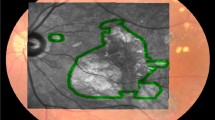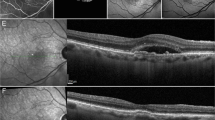Abstract
Purpose
To report chorioretinal vasoconstriction as a potential pathogenic mechanism in acute macular neuroretinopathy (AMNR). To describe a time lag between the onset of functional deficits and that of fundoscopically visible lesions and illustrate the superior value of infrared (IR) compared to red-free or white light imaging in AMNR.
Methods
Two young female patients (30 and 19 years old) with AMNR are described. Both underwent detailed clinical examination with additional imaging using IR, blue, and red-free light. Functional evaluation with pattern and multifocal electroretinography, Goldmann manual, and automated Humphrey visual fields (VFs) was also performed.
Results
The first patient was diagnosed with AMNR after a caesarian section during and after which she received treatment with vasoconstrictive drugs. She was followed up for 28 months, after which time she still suffered from bilateral U-shaped paracentral scotomata associated with macular lesions.
The second patient complained of central scotomata prior to the onset of any visible fundoscopic lesions, following a bout of flu. VFs confirmed a central scotoma and pattern electroretinography was consistent with loss of macular function. Bilateral petaloid lesions became visible after 3 days when function began to improve. In both patients IR imaging was superior to standard red-free and white light in identifying macular lesions.
Conclusions
Vasoconstriction in the chorioretina may be pathogenic in AMNR. Functional complaints precede fundus lesions in AMNR. And, IR light is superior to red-free or white light imaging in detecting typical fundus lesions in AMNR both early and late in the course of the disease.
Similar content being viewed by others
Log in or create a free account to read this content
Gain free access to this article, as well as selected content from this journal and more on nature.com
or
References
Bos PJ, Deutman AF . Acute macular neuroretinopathy. Am J Ophthalmol 1975; 80: 573–584.
Gomez-Torreiro M, Gomez-Ulla F, Bolivar Montesa P, Rodriguez-Cid MJ . Scanning laser opthalmoscope findings in acute macular neuroretinopathy. Retina 2002; 22: 108–109.
Turbeville SD, Cowan LD, Gass JD . Acute macular neuroretinopathy: a review of the literature. Surv Ophthalmol 2003; 48: 1–11.
Stilma JS, de Lange JJ, Crezee FC . Bilateral central scotoma with preservation of central vision in 2 patients following caesarean section under spinal anesthesia. Doc Ophthalmol 1987; 67: 59–68.
Browning AC, Gupta R, Barber C, Lim CS, Amoaku WM . The multifocal electroretinogram in acute macular neuroretinopathy. Arch Ophthalmol 2003; 121: 1506–1507.
Chan WM, Liu DT, Tong JP, Law RW, Lam DS . Longitudinal findings of acute macular neuroretinopathy with multifocal electroretinogram and optical coherence tomography. Clin Exp Ophthalmol 2005; 33: 439–442.
Maturi RK, Yu M, Sprunger DT . Multifocal electroretinographic evaluation of acute macular neuroretinopathy. Arch Ophthalmol 2003; 121: 1068–1069.
Shukla D, Arora A, Ambatkar S, Ramasamy K, Perumalsamy N . Optical coherence tomography findings in acute macular neuroretinopathy. Eye 2005; 19: 107–108.
Carrel T, Carrel B, Jutzi H, Nachbur B . Drug-induced acute arterial occlusion. Helv Chir Acta 1990; 57: 169–175.
Sieving PA, Fishman GA, Salzano T, Rabb MF . Acute macular neuroretinopathy: early receptor potential change suggests photoreceptor pathology. Br J Ophthalmol 1984; 68: 229–234.
Acknowledgements
We acknowledge the patients for their willingness to collaborate in this study.
Author information
Authors and Affiliations
Corresponding author
Additional information
Presented in part at the Ophthalmologia Belgica 2005 Meeting, Brussels, Belgium, 23–25/11/2005
Proprietary interests: None
Rights and permissions
About this article
Cite this article
Corver, H., Ruys, J., Kestelyn-Stevens, AM. et al. Two cases of acute macular neuroretinopathy. Eye 21, 1226–1229 (2007). https://doi.org/10.1038/sj.eye.6702543
Received:
Accepted:
Published:
Issue date:
DOI: https://doi.org/10.1038/sj.eye.6702543
Keywords
This article is cited by
-
Functional and high-resolution retinal imaging monitoring photoreceptor damage in acute macular neuroretinopathy
Graefe's Archive for Clinical and Experimental Ophthalmology (2016)
-
Acute macular neuroretinopathy misdiagnosed as optic neuritis
International Ophthalmology (2015)
-
Early features in acute macular neuroretinopathy
International Ophthalmology (2014)
-
Visualization and follow-up of acute macular neuroretinopathy with the Spectralis® HRA+OCT device
Graefe's Archive for Clinical and Experimental Ophthalmology (2010)



